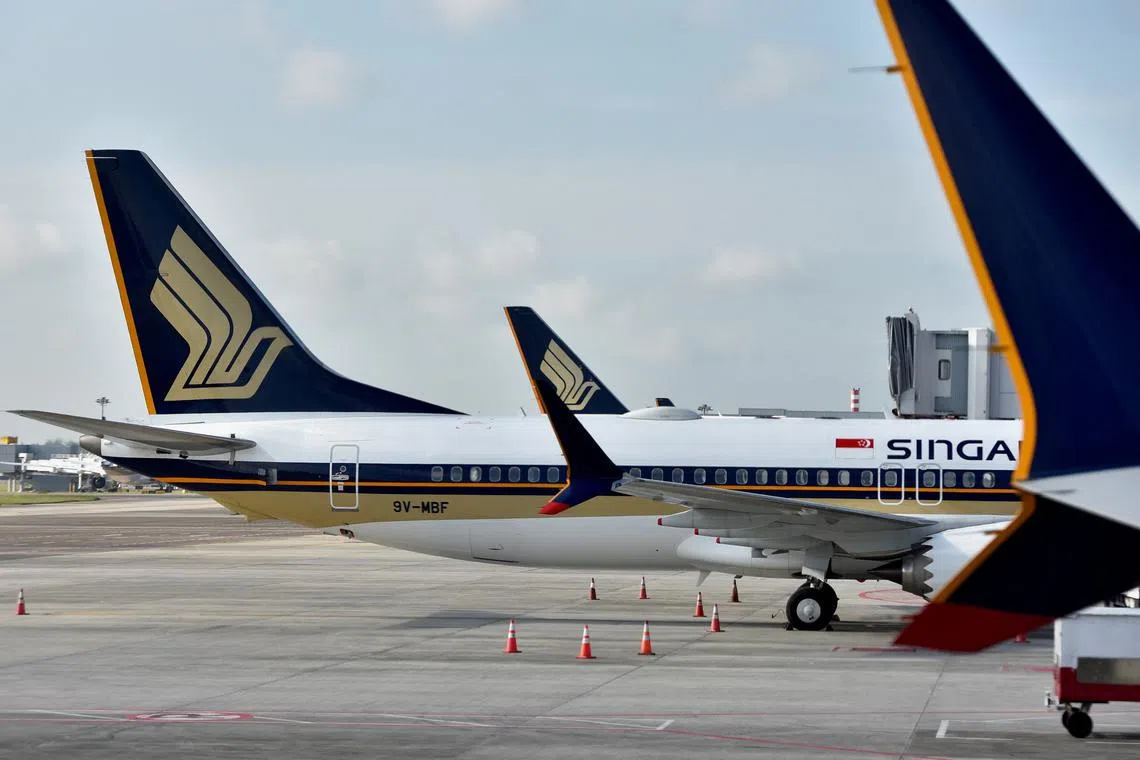SIA declares first dividends in three years as travel demand soars
Sign up now: Get ST's newsletters delivered to your inbox

Singapore Airlines Group posted a record quarter amid the resurgence of global travel.
PHOTO: REUTERS
Follow topic:
SINGAPORE - The Singapore Airlines Group declared its first set of dividends in three years on Friday as it posted a record quarter amid the resurgence of global travel.
Its net profit of $557 million for its second quarter ended Sept 30 was a whopping 51 per cent higher than the first quarter’s $370 million.
Revenue during the July-September quarter grew 14.3 per cent quarter on quarter to $4.49 billion.
This brings the group’s first half net profit to $927 million, compared with a loss of $837 million in the same period in 2021.
Revenue for the April-September period almost doubled to $8.42 billion, from $2.83 billion a year earlier.
SIA recorded an operating profit of $1.23 billion for the six months to end-September, an improvement of $1.85 billion from the $620 million loss a year before.
It also accumulated an operating cash surplus of $2.51 billion for the first half, a year-on-year improvement of $2.62 billion.
The company declared an interim dividend of 10 cents per share (tax-exempt, one-tier), amounting to $297 million, for the half-year ended Sept 30.
The dividend will be paid on Dec 22 to shareholders on the register as at Dec 12.
This came on the back of strong travel demand, which picked up earlier this year following post-Covid-19 reopenings, then accelerated through the July-September quarter.
SIA carried 6.3 million passengers during the July-September quarter, up 24 per cent from 5.1 million in the previous quarter.
For the first half, SIA carried 11.4 million passengers, which is 14 times more than the 800,000-odd passengers during the April-September 2021 period.
Passenger load factor during the quarter averaged 86.6 per cent, versus 79 per cent in the preceding quarter.
For the first half, passenger load factor was 83 per cent, versus 16.2 per cent during the same period last year.
But cargo load factor declined to 61.1 per cent during the first half from 88.2 per cent a year earlier as demand normalised in the post-pandemic period and competition picked up.
The SIA Group’s cargo network covers 107 destinations with a fleet of seven Boeing 747-400F freighter aircraft, as well as the bellyhold space of SIA and Scoot passenger aircraft.
The group flew to 100 destinations by the end of the first half of the current financial year, versus 15 destinations during the pandemic. In 2019, before the pandemic, it flew to 137 destinations.
As at Sept 30, the group’s operating fleet comprised 186 passenger aircraft and seven freighters.
This includes 131 passenger aircraft and seven freighters in SIA’s fleet, and 55 passenger aircraft in the Scoot fleet. The company has 102 aircraft on order.
On Oct 25, SIA said it intends to fully redeem the $3.496 billion mandatory convertible bonds (MCBs)
The accreted principal amount payable by SIA, being 110.408 per cent of the principal amount of the 2020 MCBs, will be $3.86 billion.
The airline group said this will be funded by the existing cash reserves, which have risen in line with the strong recovery in the demand for passenger air travel.
On the balance sheet, the group shareholders’ equity stood at $23.2 billion at end-September, an increase of $0.8 billion from March 31.
Cash and bank balances increased by $3.7 billion to $17.5 billion, primarily due to net cash generated from operations, including the proceeds from forward sales.
In addition to the cash on hand, the group retains access to $2.2 billion of committed lines of credit, all of which remain undrawn.
Total debt balances edged up $0.1 billion to $15.8 billion, mainly due to the increase in lease liabilities as a result of sale-and-leaseback activities. Consequently, SIA group’s debt-equity ratio decreased from 0.70 times to 0.68 times.
The company said elevated fuel prices remain a concern in the months ahead. But it added that higher fuel prices are an issue that affects the entire airline industry.
In mid-October, SIA confirmed it was in discussions with India’s Tata Group
SIA said this was a key part of its “multi-hub strategy”, which allowed it to directly participate in the growth of one of the largest aviation markets in the world that complements its Singapore hub.
SIA also has significant partnerships with Air New Zealand, All Nippon Airways, Garuda Indonesia, Lufthansa, Malaysia Airlines, Scandinavian Airlines, United Airlines, and Virgin Australia.
Going forward, SIA expects demand to remain strong heading into the year-end peak travel season.
“With the recent relaxation of border controls in parts of East Asia, we expect demand to pick-up in Hong Kong, Taipei, and points in Japan, especially over the holiday period,” it said.
“Forward sales are expected to remain buoyant in the coming months leading up to the Chinese New Year period.”
But cargo demand in the third quarter of FY2022/23 is projected to be weaker on a year-on-year basis, as this year’s traditional air cargo peak period is expected to be muted.
SIA attributed this to the anticipated impact of global economic headwinds on consumer demand, and fewer production orders as importers work on reducing high inventories.
The progressive return of industry bellyhold capacity with the resumption of more passenger flights will also put downward pressure on cargo yields, SIA added.


